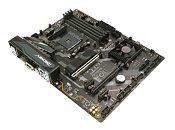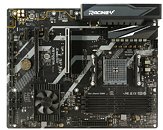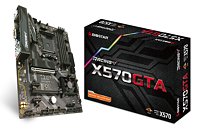Thursday, October 17th 2019

Biostar Announces the Racing X570GTA Motherboard
BIOSTAR, a leading manufacturer of motherboards, graphics cards, and storage devices, is proud to launch a new addition to its 4th generation of RACING motherboards with the powerful yet humble BIOSTAR RACING X570GTA. Built with designers and content creators in mind, the RACING X570GTA combines a set of onboard features to ensure that quality content can be produced with a system that users can rely on. The BIOSTAR RACING X570GTA is tastefully designed with the iconic BIOSTAR RACING GEN 4 features and grey lightning strikes that represents the lightning-fast performance and ultra-responsives that gives gamers the competitive edge to take their gaming experience to the next level.
The BIOSTAR RACING X570GTA, equipped with the latest X570 chipset for AMD socket AM4, brings support for 3rd Gen Ryzen processors, an essential tool for content creators. While designers rely on high performance and responsiveness to render videos or 3D content, which is supported by the RACING X570GTA PCI-e 4.0 lanes (offering bandwidth of 64 GB/s and compatibility for the latest as well as previous generation graphics cards), the users can rest assured their investment in high-end hardware is secured with the BIOSTAR's exclusive Iron Slot Protection on the x16 lanes which helps handle heavier graphics cards, prevent bending, and extend the longevity of the slots. In addition, PCI-e 4.0 also opens the door to PCI-e M.2 4.0, the latest storage interface which delivers the highest bandwidth (64 GB/s) and offers lower latency, making launching programs such as video and photo editing software, and accessing heavy files a flash.While great bandwidth and fast processing power are the best allies for those who deal with heavy workload and large files, it is mandatory to equip your system with enough RAM that will be on par with the rest of your fast hardware to ensure smooth multitasking and quick responsiveness. That is why the RACING X570GTA supports up to 128 GB of DDR4 memory spread over the 4-DIMMs which can be overclocked at 4000+ MHz for an additional boost in performance. In addition, USB 3.1 Gen1 (5 Gb/s) and HDMI 4K resolution support, both guarantee simultaneous compatibility with a multitude of devices and monitors and provide the best visual experience with vivid colors, brightness and highly detailed content.
Feature Highlights
Whether you are a casual Youtuber, create 3D content, or do professional video editing, the BIOSTAR RACING X570GTA will not let you down. Combining the power of AMD 3rd Gen Ryzen processors, fast memory, high bandwidth storage and support for the latest and greatest graphics card, the RACING X570GTA offers the right set of reliable features to make your PC the ultimate powerhouse and give you the edge needed to bring up at the top of your game.
For more information, visit the product page.
The BIOSTAR RACING X570GTA, equipped with the latest X570 chipset for AMD socket AM4, brings support for 3rd Gen Ryzen processors, an essential tool for content creators. While designers rely on high performance and responsiveness to render videos or 3D content, which is supported by the RACING X570GTA PCI-e 4.0 lanes (offering bandwidth of 64 GB/s and compatibility for the latest as well as previous generation graphics cards), the users can rest assured their investment in high-end hardware is secured with the BIOSTAR's exclusive Iron Slot Protection on the x16 lanes which helps handle heavier graphics cards, prevent bending, and extend the longevity of the slots. In addition, PCI-e 4.0 also opens the door to PCI-e M.2 4.0, the latest storage interface which delivers the highest bandwidth (64 GB/s) and offers lower latency, making launching programs such as video and photo editing software, and accessing heavy files a flash.While great bandwidth and fast processing power are the best allies for those who deal with heavy workload and large files, it is mandatory to equip your system with enough RAM that will be on par with the rest of your fast hardware to ensure smooth multitasking and quick responsiveness. That is why the RACING X570GTA supports up to 128 GB of DDR4 memory spread over the 4-DIMMs which can be overclocked at 4000+ MHz for an additional boost in performance. In addition, USB 3.1 Gen1 (5 Gb/s) and HDMI 4K resolution support, both guarantee simultaneous compatibility with a multitude of devices and monitors and provide the best visual experience with vivid colors, brightness and highly detailed content.
Feature Highlights
- PCI-E 4.0: PCI-E 4.0 is the next evolution of the ubiquitous and general-purpose PCI Express I/O standard. At 16GT/s bit rate, the interconnect performance bandwidth is doubled over PCI-E 3.0, while preserving compatibility with software and mechanical interfaces.
- VIVID LED DJ: Adjusting the color of LED and changing system colors by VIVID LED DJ gives the user complete control over the process of PC modding, helping to develop their personal style. Users can fully customize the on-board LEDs, as well as the external LED devices such as LED strips, LED fans, and RGB LED memory modules.
- RAZER Chroma: Compatible BIOSTAR RACING motherboards utilize BIOSTAR VIVID LED DJ to sync with Razer Chroma.Combined together, gamers can embrace full immersion into their adventures with the system lights are synchronized to the in-game effects, providing instant feedback to every action and event.
- LED Rock Zone: LED ROCK ZONE comes with an RGB 12 V LED header and a Digital 5 V LED header which offers more colorful lighting options to DIY lovers.
- Racing Armor: The new Racing Armor comes with I/O Armor to protect I/O interfaces from static electricity.
- Super LAN Surge Protection: Super LAN Surge Protection provides LAN port with more advanced antistatic protection capabilities by adding an integrated chip to strengthen electrical stability and prevent damage from lightning strikes and electrical surges.
- A.I Fan: The A.I Fan, which has an automatic detection system, is used to detect the temperature of the PC to make the fans operate at defined speed for optimal cooling performance. It can maintain the operating temperature of your PC to ensure optimum performance and also save more energy.
- The BIOSTAR RACING X570GTA rear I/O features: 1x PS/2 Keyboard, 1x HDMI Port, 1x VGA Port, 1x GbE LAN port, 4x USB 3.1 Gen1 (5 Gb/s) Ports, 2x USB 2.0 Ports and 3x Audio Jack.
Whether you are a casual Youtuber, create 3D content, or do professional video editing, the BIOSTAR RACING X570GTA will not let you down. Combining the power of AMD 3rd Gen Ryzen processors, fast memory, high bandwidth storage and support for the latest and greatest graphics card, the RACING X570GTA offers the right set of reliable features to make your PC the ultimate powerhouse and give you the edge needed to bring up at the top of your game.
For more information, visit the product page.



24 Comments on Biostar Announces the Racing X570GTA Motherboard
BIOSTAR, while i appreciate the comical relief your product launches keep bringing us, at least trying to make a product that looks to par can help.
Also, please don't feed us how this is made for content creators, with its dinky and minimal IO.
Anyway, otherwise, if this motherboard is cheap, I have no problems with it tbh.
This particular model is at $159 in small bulk (10ct min order), so I expect it to be sub $200 in retail.
Now, the board itself is a mixed bag of beans and gravel... From the first look it's OK, but as soon as you look closer at pics... :banghead:
* RTL8111H & ALC887 is about as cheap as it currently gets (nowadays prices are pretty much the same as their old lowball combo RTL8111G * ALC662).
* VRM is 4+2 (fake x8 CPU phases). Single M.2 slot and a big-ass hole where the second one is supposed to be. Rear I/O straight from their low-budget H110 boards, with the usual "7.1" audio marketed, but only possible via S/PDIF header which they forgot to put on the board. I mean, WTF? Enough BOM budget for two RGB headers and two separate LED drivers, but not enough to stick a 4-pin dupoint header for S/PDIF?
* Once again, bullshit about DDR4-4000 support. As with other similar boards, only tested with the exact same set of 4GB/8GB G.Skill rated at much higher XMP clocks and very loose timings (e.g. a DDR4-4000 kit would not run, but DDR4-4133CL19 kit downclocked to 4000 will).
That fan looks almost replaceable, something that needs to be considered
Not a bad looking board, performance will be key, Biostar have actually been moving up the quality ladder the last few years.
Their first favorite(which is used on a "slightly bigger brother" X570GT8 and a ton of X470 boards) is an IR35201. Neither of those can do 8+2.
... And to avoid further questions: no , BIOSTAR never made a VRM with doublers, and I highly doubt this will be an exception (especially at $160 price point).
But overall I recommend watching all of his vids (or at least as much as you can) and definitely subscribe, cause he's a cool dude and one of the very rare overclockers and PC enthusiasts who actually knows his $h1t, and who's methods don't rely on throwing money at the problem.
You get some benefits, like:
- Higher current capability with lower quality/cheaper mosfets
- Lower overall temps, comparing to regular 4-phase
- Most importantly, it looks better and more expensive than it really is
- It saves a ton of money on other board components (no doublers, no extra drivers, less passives, smaller heatsink)
But it also comes with all the drawbacks of cheap VRM (ripple, bad or absent load balancing, higher chance of failure etc.)
Biostar are not the only ones doing this (pretty much every OEM is guilty of mis-marketing), and sometime around Haswell this crap started to spill even into the high-end segment.
OEMs figured out that if modern CPUs are not power-hungry and bad at overclocking, then they can get away with cheaper VRMs and Intel/AMD takes the blame: e.g. customer thinks he simply didn't win the silicon lottery, but the culprit is the output ripple or one of the other "side effects" of 4-phase setup.
I kinda got baited into buying Gigabyte X470 AORUS Ultra Gaming, which has the same fake 8-phase on the same ISL95712 (there were no reviews at the time for this board). But at least in my case no overclocking ability(I mean - none whatsoever) was compensated by a very decent price and tons of other useful features.nope. It does not use doublers.
For me, if this board was about $150 CAD, I can see myself picking it up and placing a 3600 in it. I could also use it to build machines for others who are not going to be using even remotely half the functions most high end boards offer.
Also, if BIOS compatibility is a concern, most in-store new boards should have a label indicating that it's "3000-series ready".
For example, MSI X470 Gaming Pro Carbon costs around $160-$180 USD. It's a 5+2, but uses much better components in its power stages. Even my Gigabyte AORUS Ultra, as shitty/deceptive as it is, can be a better option thanks to its bad-ass RAM overclocking ability and tons of features in a sub $150 range (assuming you don't OC your CPU at all).
Additionally, we already have some semi-decent low-budget X570 boards from respectable OEMs, like ASUS TUF X570-Plus, GB X570 AORUS Elite, etc. etc. etc.
x470 are not much different in prices either. MSI x470 Gaming Plus is about $150. I mean, I am OK with that myself. Asrock SLI Master x470 is about $160 CAD. No guarantee though they will be updated bios to handle the Ryzen 3000 series. Best I can do is go to local place and see to price match the MSI one and if they will also update bios for me too.
B450 is the sweet spot. I am more or less waiting for B550 motherboards.
It works just fine, because of the above. You wont find a board these days that uses VRM's that are not capable of delivering at least the required power a modern AMD cpu needs. You can see that the maximum overclock is still not limited on a 50$ board with a cheap VRM. The culprit of high clocks is really the proces AMD cpu's are made on.
So it does'nt really matter if your getting a 400$ board or a 50$ board, if your going to use it for daily purposes such as gaming, work and all that its just fine. You will however often run 'hotter' with a board that holds a cheap VRM setup with no heatsinks at all. But if your using a Air-based CPU cooler that blows air around the socket, your really fine. VRM's can take 100 degrees all day, that's what they are made for. The system wont run faster if it has big cooling or not. A big VRM only helps at certain overclocks, or you want the luxury to pump up the switching frequency for example. With most boards it's like 200 ~ 300 khz. My board does 600khz and i've dialled it in at 500Khz.
With the 500khz setting my CPU can work with a lower overall voltage and still be stable compared to a default switching frequency.
HAHA LOL when's the last time you ever seen or heard of this actually being a problem for modern PC's I know I haven't seen it for over 20 years and as for the "With content creators in mind" don't make me laugh even harder than I already am this mobo is for Cheap ass budget builders and nothing more